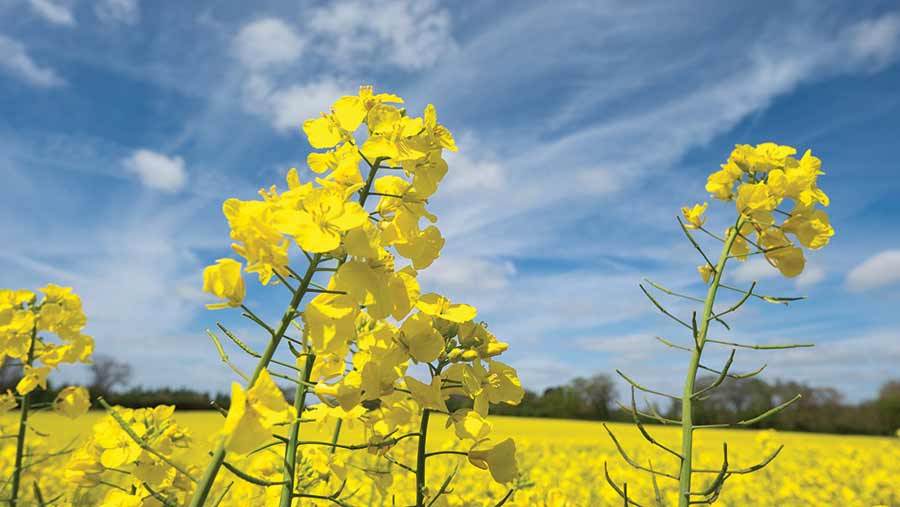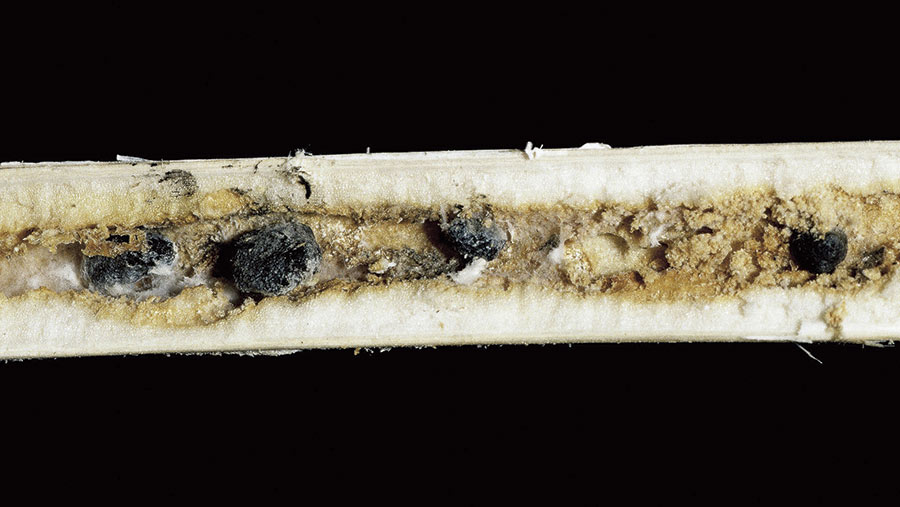Two fungicide sprays may be needed for flowering oilseed rape
 © Tim Scrivener
© Tim Scrivener Oilseed rape growers may need two fungicides to beat sclerotinia stem rot in this year’s likely long flowering season, which is tending to mirror the high epidemic year of 2007.
A long flowering season means a greater risk from diseases, such as sclerotinia, which can be exacerbated by light rain or heavy dew and warm weather at petal fall.
Even though the spring has been dry and not particularly conducive to sclerotinia, infection levels are high and two fungicides might be warranted this spring, especially as the current cool weather is likely to extended the flowering period when crops are at risk.
See also: Wet weather heightens risk of stem rot in oilseed rape
Actives
- Proline – azole prothioconazole
- Pictor – SDHI boscalid + strobilurin dimoxystrobin
- Amistar – strobilurin azoxystrobin
Julie Smith, senior researcher at crop consultant Adas, says most of its monitoring sites are showing that 50% of oilseed rape petals are infected, with some having 100% petals infected. So the risk is there if the weather does warm up and it rains.
“If the crop flowering period is extended and the disease pressure is still high, we would advise a second spray,” she tells Farmers Weekly.
Season similar to 2007
This season looks uncannily similar to 2007, when conditions at flowering were dry, but there were lots of disease spores that caused yields to fall 80% in some trials in Herefordshire, she adds.
The disease fungus can survive in the soil for many years. Resting bodies, or sclerotia, germinate in the spring and spores may adhere to petals, which can then stick to stems and leaves as the petals mature and fall off.
Wet weather will encourage petals to adhere and so infect stems and leaves, leaving stunted crops and often leading to the premature death of plants.
A so-called sclerotinia infection event occurs when temperatures are above 7C and air humidity is more than 80% for a minimum of 23 hours from mid-flowering to the start of petal fall.
The Adas petal testing showing high levels of infection suggest it will only need light rain or a heavy dew for spores to germinate and petals to stick to the crop
“Just because it has been so dry, growers should not neglect the risk of sclerotinia, especially as it could be a season just like 2007,” Ms Smith says.
Two sprays
If growers do go with two sprays, they should be looking to use fungicides with different modes of actions for good resistance management and to control other diseases, such as light leaf spot.
Popular fungicide products used for sclerotinia include the azole Proline, SDHI-strobilurin combination Pictor and the strobilurin Amistar.

Sclerotinia infection in OSR stem © Blackthorn Arable
Will Foss, regional technical adviser in eastern England for agronomy group Agrii, says it could well be a two-spray season, especially if the weather turns warmer and wetter as petals start to fall.
“This will probably be a two-spray season with one around now at mid-flowering and then another three weeks later,” he says.
Mr Foss advises both sprays should be a mix of an azole and non-azole, and if growers opt for two sprays, they can cut back on dose rates.
Crops in eastern England hit by damage from cabbage stem flea beetles and poor establishment in a dry autumn may see extended flowering and could well benefit from a second spray.
Even flowering
Gareth Bubb, commercial technical manager at agrochemical group Bayer, says many growers in his area of Herefordshire will be going with one spray as average temperatures are currently low.
“We are seeing very even flowering, but further east with flea beetle damage and poor autumn emergence there may be more need for a second spray,” he says.
He advises the best sclerotinia sprays products are based on prothioconazole or boscalid, and if a second spray is needed, growers could cut dose rates for that second treatment.

